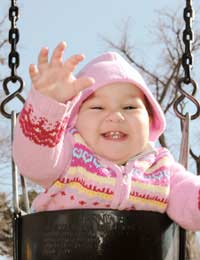Setting up Safe Play Areas for Children of Varying Ages at Day Nurseries

Nurseries typically provide care for children of varying ages, so it is imperative that the owners and management staff pay special attention to matters of safety, assuring that as children play games, whether indoors or on outdoor playgrounds, they remain as safe as possible. Providing designated areas for different age groups can help, as the needs and interests of babies, toddlers and preschoolers can be quite different than those of older kids.
Safe Play Areas for Babies and Toddlers
Babies and toddlers need constant supervision because they have not yet developed the ability to discern for themselves which activities might cause them harm. They are inclined to put everything that they touch into their mouths, so areas designated for babies and toddlers should be free of small toys and those with small parts that may come loose. Tables and other furniture in baby play areas should have rounded corners, preferably cushioned to minimise injuries as babies learn to pull themselves into standing positions and take those first unsteady steps. Age appropriate playthings, designed to encourage safe exploration, should be in ample supply, with attentive caregivers close at hand to provide encouragement and assistance.Safe Play Areas for Preschoolers and Older Children
As they get older and more capable, kids need outlets for their natural energy, but safety must still be a top priority when choosing games and activities. Responsible, adult supervision is always necessary, but older children need to be allowed a bit of autonomy in order to develop not only their physical capabilities, but also their confidence. Indoors, older kids need access to toys, books, and craft supplies designed to stimulate their imaginations whilst increasing their general knowledge and improving their fine motor skills. Preschool aged kids will need direct supervision when using scissors and some may still need to be reminded not to put objects into their mouths.Safe Outdoor Play
Playing outdoors is not only pleasurable for most kids, but it is good for them, as well. A little fresh air and sunshine (with proper sun protection, of course) can lift kids’ moods and can even help them to sleep better. Climbing frames and all other playground equipment must be properly installed in accordance with the highest safety standards, kept in good repair, with no bolts or screws protruding, and inspected regularly to assure that they remain safe for children’s use. Grass or wood chips are no longer considered safe surfacing materials, with rubber mulch or another shock absorbing material preferred.Ideally, nurseries will have ample room to accommodate at least some outdoor play equipment for use by babies and toddlers, who can derive many of the same benefits from physical activity that their older peers enjoy. Safe baby swings and small climbing pieces are terrific choices for little ones, just so they are kept separate from those used by older, more boisterous children.
Finally, all children should be instructed on the nursery’s safety rules, and must understand that these rules are in place to protect them from harm. Kids must be taught to use playground pieces for only their intended purposes and that courteous play habits are essential for the safety of all children. Pushing, shoving, and rough play cannot be permitted, and children who refuse to cooperate with safety rules should be asked to sit away from the group for a few minutes, until they agree to interact in a safe and considerate manner.


Re: What Licence do I need to Operate a Nursery?
Hi,I am interested in opening up a nursery.i have worked as an administrator for the NHS for 10 years. Just…
Re: What is a Montessori Nursery?
Hi, I needed guidance, in order to open a Montessori nursery. I am a stage 4 qualified Montessori teacher with an experience of…
Re: What Qualifications Are Needed to Run a Nursery?
Hi I have 13 years in health and social care for adult and about a year for children in respite care. I…
Re: How to Ensure Sufficient Staff Coverage at Day Nurseries
I know someone who works in a nursery where She is left alone with 8 children who range from…
Re: What Licence do I need to Operate a Nursery?
Hi, I worked as nursery/primary/secondary schools administrator and in HR. I am interested in opening a…
Re: What Qualifications Are Needed to Run a Nursery?
I am an Indian. What qualification would need to become a owner & teacher of nursery school?
Re: What Licence do I need to Operate a Nursery?
Bushra - Your Question:I am a qualified primary teacher ( 5-11 years). It has always been a dream of mine to…
Re: What Licence do I need to Operate a Nursery?
I am a qualified primary teacher ( 5-11 years). It has always been a dream of mine to set up my own nursery…
Re: What Qualifications Are Needed to Run a Nursery?
What qualifications is needed to open a day nursery in Northern Ireland
Re: Tips for Setting Fees at Your Day Nursery
Hello, I am wanting to set up a day nursery. I am a qualified secondary school teacher with 4 years experience. I…